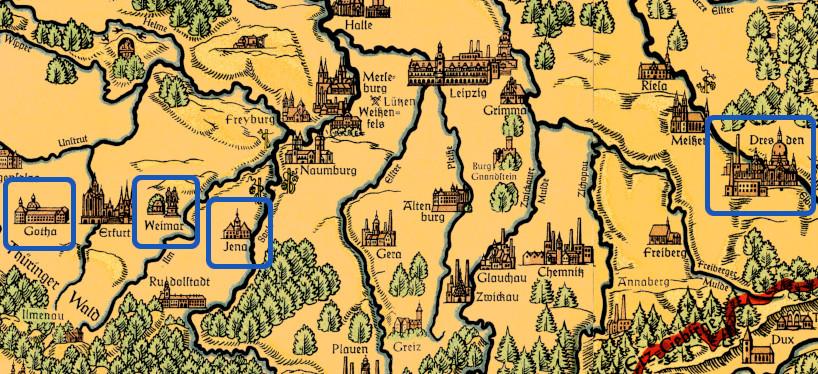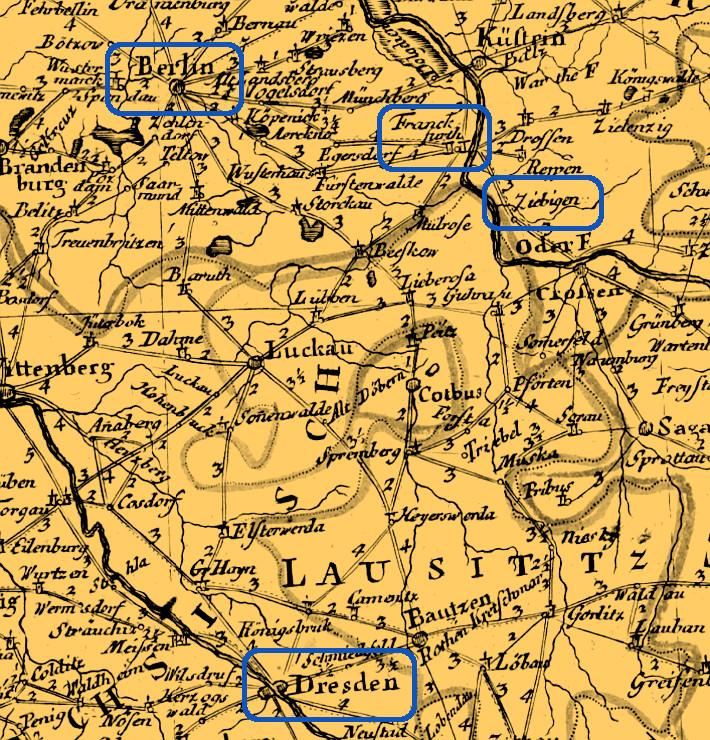• 366. Caroline to Cäcilie Gotter in Gotha: Jena, late June 1802
[Jena, late June 1802]
|336| My dear Cecile, let me immediately relate the following to you from one of Schlegel’s letters:
“I immediately addressed the matter you requested concerning Cecile. [1] The Tiecks cannot offer her accommodations and will, moreover, perhaps be departing themselves during the second half of the summer. [2]
Madam Rehkopf is too occupied for now and also lives in a garden area, which would present difficulties for Cecile considering her study obligations mornings and afternoons in town. [3] I spoke at length with her about this. She mentioned a certain Madam Canzler, who boards several other young women without any real supervision, one of whom is studying music. [4] She will allegedly do her best to secure Cecile a place there or elsewhere and will thus be writing to you in that regard.
In this way, I do believe I have left your request in the best of hands, since Madam Rehkopf is acquainted with a great many people. My sister is still living out in the country. The Tieks are not acquainted with anyone, nor are they really suited for it.
But you must prepare Cecile for the fact that she will not really find anything in Dresden other than the opportunity to see the works of art there (cela suffit). [5] There is no instruction to speak of because no one will get involved in that way, and the older artists also paint in a style that, if followed, constitutes the surest path to ruin.
She must, of course, certainly let Döll introduce her to Grassy, Graf, and Seidelmann, [6] but she must be wary of viewing them as excellent painters. I will myself recommend her to Büry and Hartmann, but neither is very communicative nor is either really suitable for providing guidance. [7] Büry, however, does go to the gallery daily and can thus probably advise her what she should be copying and can have a look at what she then comes up with.
She must also pay attention to Mademoiselle Alberti, who since she is no longer under the guidance of Gareis has actually made considerable progress and |337| has painted some portraits that are quite nice, though she insists she hardly knows how to advise herself, much less others.
It would be quite good if Tieck were willing to accompany her around the gallery if only to give her an idea of what she should see, since otherwise she will likely receive false guidance in this regard as well. I will be glad to urge him to do so.
There is a Frenchman there, a certain Auda [8] (who is, however, now leaving), a horribly affected scrawler to whom people have indeed brought young artists for instruction, including Mademoiselle Körner, and Madam Rehkopf has mentioned him as someone to whom one might also entrust Cecile; that is how little people really understand what is good or bad.”
__________
I had already copied out part of the above for you a week ago, my dear Cecile, but it then just lay there unsent, and in the meantime I spent several days in Lauchstädt attending the opening of the new theater with an extremely charming and quite interesting prologue by Goethe. [9] Tell Julchen that I really wish she could have been with me so that she, too, might have taken part; she would have had a grand time of it. I also saw a performance of The Brothers on this occasion. [10] If in that week Alarcos and several other plays are performed [11] . . .
[End of sheet.]
Notes
[1] At issue is the possibility of Cecile Gotter continuing her training in portraiture in Dresden, including with help from the family of Ludwig Tieck (Rudolf Koch and Fritz Kredel, Deutschland und angrenzende Gebiete [Leipzig 1937]):

Caroline last mentions the matter to Wilhelm in her letter to him on 18 June 1802 (letter 364); he here conscientiously addresses most of the issues, whose answers he pursued while in Dresden after he accompanied Caroline and Schelling to Leipzig on 19 May 1802.
See also Caroline’s letter to Julie Gotter on 15 June 1802 (letter 363), note 7, and the pertinent section in Julie Gotter’s letter to Cäcilie on 14 December 1801 (letter 335d.1). Back.
[2] Departing possibly for Giebichenstein, then, with more certainty, for Ziebingen; see Caroline’s letter to Julie Gotter on 15 June 1802 (letter 363), note 6 (Franz Ludwig Güssefeld, Neue und vollstaendige Post-Carte Durch ganz Deutschland [1804]; Bibliothèque nationale de France):

[3] Unidentified; possibly Christiane Brigitte Rehkopf, widow of a former high consistory councilor and church superintendent in Dresden. Caroline mentions her earlier in this same capacity in her letter to Julie Gotter on 24 April 1802 (letter 357).
“Garden houses” were generally understood to be located outside the main part of a given town. Concerning Schiller’s garden house outside Jena, see Caroline’s letter to Luise Gotter on 13 February 1797 (letter 179), note 11. Garden houses outside Dresden, a larger town in any case, could be considerably farther outside town than was Schiller’s. Back.
[4] Madam Canzler in Dresden is unidentified.
Cäcilie was already twenty years old and would then likely be living with young women of a similar age (Gottlieb Böttger, Lehrer und Schülerin an einem Tasteninstrument; Stadtgeschichtliches Museum Leipzig B 220a):

[5] Fr., “that suffices, will suffice.” Back.
[6] Cäcilie Gotter had been studying under Wilhelm Döll in Gotha; the other painters were currently in Dresden. Back.
[7] Caroline had mentioned Christian Ferdinand Hartmann to Julie Gotter in her letter to her on 24 April 1802 (letter 357) as a possible tutor for Cäcilie. Back.
[8] Or Aude; uncertain identity. Back.
[9] Caroline and Schelling were in Lauchstädt for performances on 26 and 27 (and possibly 28) June 1802 and likely arrived earlier than the actual first day of performance.
Goethe’s prologue Was wir bringen (Tübingen 1802), specifically written for the dedication, and Mozart’s Titus (La clemenza di Tito; Germ. Die Milde des Titus, often known earlier simply as Titus [e.g., Das Repertoire des Weimarischen Theaters, 43]) were performed on the first evening.
Concerning the opening of the new Lauchstädt theater and the prologue itself, see Nicholas Boyle, Goethe: The Poet and the Age, vol. 2, Goethe: Revolution and Renunciation (1790–1803) (Oxford 2000), 726ff. Back.
[10] Friedrich Hildebrand von Einsiedel’s play Die Brüder. Ein Lustspiel nach Terenz in fünf Akten (Leipzig 1802) was performed on 27 June 1802 in Lauchstädt. Back.
[11] The sentence fragment is probably to be continued: “we will return to Lauchstädt to attend.”
Friedrich Schlegel’s play Alarcos (Berlin 1802) had premiered in Weimar at the end of May and was then performed in Lauchstädt on 13 and 14 July 1802. By that time, however, Friedrich himself and Dorothea Veit were in Paris. Caroline and Schelling did not attend either.
See Caroline’s letter to Sophie Bernhardi in late May, early June 1802 (letter 361) for a partial schedule of the Lauchstädt performances. Back.
Translation © 2016 Doug Stott
